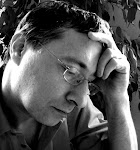In the old days of cinema, before polarising glasses, I never used to sit irritated in the dark thinking - this is far too flat for me. Why? Because through the art of the cinematographer, the image projected onto the 2D screen had 3D depth.
It is a trick of the mind and the eye so subtle that I was never even aware of it until I started to make films myself. The subject - the thing on the screen which the film maker wanted to direct my eye to - was in perfect focus. Other things, closer to the camera or further away, were softened. The slightest of out-of-focus blur.
This so closely maps onto the way we experience depth of field in everyday life that in watching a 2D movie, the mind tells us some things are further away and other things closer. A flat screen becomes 3D.
But in the old days those three dimensions were trapped behind the screen. Modern 3D extends out into the space between the screen and the audience. It offers that spooky moment when the Cheshire Cat hovers in the air just in front of you and speaks in Stephen Fry's voice.

For that moment of magic however, a payment is required. A thirty percent loss in colour. The hassle of having a pair of uncomfortable glasses pressing down on your nose - over your own glasses if you are short sighted like me. And a substantially more expensive cinema ticket.
There is also a strange mismatch between the old and the new systems of indicating depth. The subject is still in focus, the background and foreground are out of focus. But now some of those out of focus things are floating around in the air just in front of you. I find my eye is no longer pulled only to the thing I should be looking at, but jumps between things at different depths. They remain out of focus, which my brain finds hard to accept. The experience is disorientating and mildly unpleasant.
Perhaps we are in an age similar to the end of the silent era, when cinematographers were experimenting with the new technology and hadn't quite got it right. Or perhaps this is an unneeded technology. Time will tell. But for now, given the option, I'll be going for 2D screenings.
And here, for your enjoyment, is Mark Kermode and Simon Miller's revolutionary invention - glasses that allow you to see 3D screenings in spectacular, immersive 2D.

9 comments:
This reminds me of when PowerPoint first came out as a mainstream product. All of a sudden, speakers could create special effects on their visual aid mechanism. You still see inexperienced speakers using PowerPoint special effects with wild abandon, until they come to realise that this distracts the listener from the talk rather than enhancing it.
Tim
Thanks for that Tim,
But don't get me started on Powerpoint! Perhaps if they'd called it 'Counterpoint' people would have better understood how to use it.
Rod
Thanks for the explanation. Now I understand!
Hi Morag,
Does the explanation make sense to you - in terms of your experience of 3D cinema?
On the whole I'll usually go to the 2D version of a film if it's on at an acceptable time. Over the last year I saw quite a few in 3D and only three made any good impression:
How To Train Your Dragon - great use of the 3D in the flight scenes.
The Final Destination - only one moment in the entire film where a sticking plaster floated close to my face in an underwater scene. Rest of it was "meh".
Harry Potter - and I think then only because it was also on IMAX. A shame it was only the opening 15 minutes that were in 3D.
Second comment so I can subscribe to follow-ups. Blogger seems to have broken its comment form recently *grr*
Hi Mosher,
I also enjoyed how to train your dragon. A fine film. But I'm not sure I would have enjoyed it less in 2D.
I don't understand about the follow-up comment. Could you explain please.
Rod
Rod - I've noticed this on all the Blogger blogs I visit now. When I first arrive, I'm not logged in. So I enter my comment, the word verification (when the picture appears) and my login details.
There is no check box for subscribing to comments until *after* I've posted the comment and - at the same time - logged in. As such, I have to post a comment then post another (after logging in) to tick the now-present "receive new comments" box.
Not sure when this changed, but it's annoying!
Thanks for the explanation. Needed to be sure it wasn't the settings I have chosen.
Post a Comment